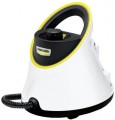Power
Rated power consumed by the steam cleaner during operation. Usually, it is indicated by the maximum power consumption when used in normal mode, without abnormal situations.
In general, this parameter is secondary when choosing: manufacturers select power in such a way as to provide the necessary indicators of productivity, pressure, etc. However, some practical points are also associated with power. So, with the same performance (see "Steam intensity"), a more
powerful device will spend less time heating water and generating steam; it can also be provided with a more capacious boiler (see "Water boiler volume"), which is useful for long-term continuous operation. On the other hand, such devices turn out to be more expensive, and often also heavier and larger than relatively “weak” steam cleaners, and besides, they load the mains more.
The second point related to power is the calculations of the load on the wiring and various electrical equipment (protective automation, AVRs, generators, etc.).
Max. steam pressure
The maximum steam pressure at the outlet of the working nozzle that the steam cleaner can create.
High pressure has a positive effect on the intensity of impact and the depth of penetration of steam; this is especially important when removing old dirt, as well as when processing carpets, upholstery and other similar materials. On the other hand, an increase in operating pressure affects the weight, price and power consumption of the device.
As for specific figures, pressure up to 3 bar is considered very low; such indicators are found mainly among steam mops (see "Type"), as well as in the simplest household steam cleaners (including manual varieties). 3.1 - 4 bar – average figure; it, in particular, corresponds to most household devices, as well as the simplest professional models. And more than 4 bar can be found mainly in advanced units, although there are exceptions to this rule.
Steam flow
The steam flow provided by the steam cleaner. For models with power and/or humidity controls, this item indicates the maximum possible value.
When choosing according to this indicator, note that the performance characterizes only the amount of water steam produced by the device per minute. The intensity of the impact of this steam on the treated surface/product can be different, first of all, it depends on the working pressure. Therefore, only devices with similar pressure indicators can be directly compared by this indicator. In such comparisons, it is worth assuming that
high performance allows to cope with larger volumes of work faster, but requires more powerful heaters and capacious tanks – which, in turn, affects the dimensions, weight and price of the entire steam cleaner.
Heating time
Heating time until steam is generated. The duration of the heating process directly depends on the power of the device and the volume of the water tank.
Note that the actual heating time may be less than the claimed one. For example, if the main tank is not filled full, and the design does not provide an additional tank for cold water. For a full guarantee, you should still focus on the value directly stated in the characteristics.
Limescale protection
A system that prevents the formation of scale inside the steam cleaner's boiler.
Scale – insoluble limescale – produces several undesirable effects at once. Firstly, it reduces the efficiency of the heating element, and over time it can completely disable it. Secondly, particles of scale can peel off the surface of the boiler and contaminate the pipes, hoses and attachments of the steam cleaner. Thirdly, upon contact with the washed surface, such particles can form new contaminants, sometimes they will be very difficult to remove. Scale is formed especially quickly when using "hard" water, with a high content of calcium salts; however, even "soft" water is not insurance against this phenomenon.
To avoid all this, modern steam cleaners provide
limescale protection. This function is usually performed by a special filter that removes calcium salts from the water; in other words, scale still settles in the device, however, not on critical structural elements, but on a part specially designed for this purpose. Note that filters have a limited resource and require periodic replacement (and the harder the water, the more often such a replacement will have to be done).
Nozzle compartment
A special compartment for storing nozzles and other accessories, usually located directly in the body of the steam cleaner.
Note that most often the
nozzle compartment is designed for accessories of a relatively small size. However, even such a device greatly simplifies the storage and transportation of the device: for additional items you do not have to look for a separate package.

